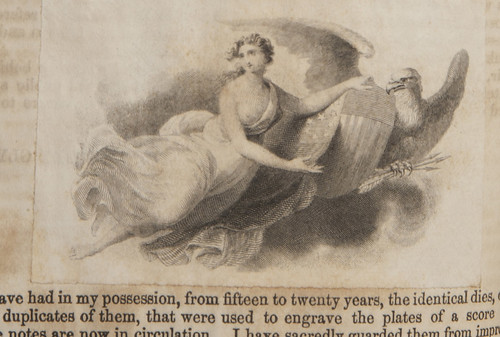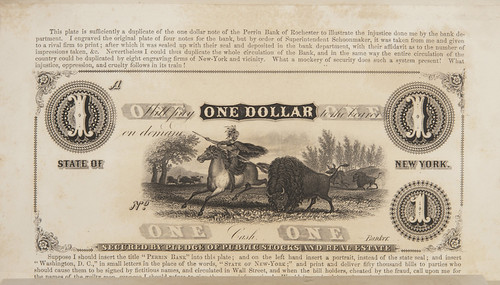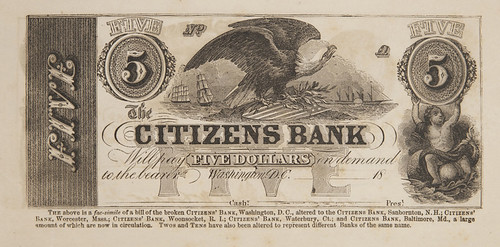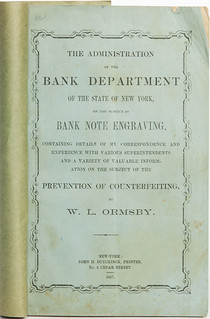
PREV ARTICLE
NEXT ARTICLE
FULL ISSUE
PREV FULL ISSUE
ORMSBY'S 1857 BANK NOTE ENGRAVING PAMPHLETAt my request book dealer Gil Parsons kindly provided this excerpt from the anniversary catalog of his firm Parsons Books. Last week we looked at one of the rarest books on U.S. paper money, Waterman Lilly Ormsby's 1852 work on banknote engraving. This week we examine an even more rare item - Ormsby's 1857 pamphlet. Thank you! -Editor ORMSBY, W.L. The Administration of the Bank Department of the State of New York on the Subject of Bank Note Engraving containing details of my correspondence and experience with various Superintendents and a variety of valuable information on the subject of the prevention of counterfeiting New York: John H. Duyckinck Printer, 1857 This extraordinary discovery, seemingly unrecorded in either general or specialist bibliographies, constitutes Ormsby’s response to charges leveled against him following the publication of his magnum opus. From the Preface: “These ‘details of correspondence’ are necessarily a relation of private wrongs, but they lead to a revelation of matters affecting the administration of the office of Superintendent of the Bank Department, involving such important principles of official duty, and of public safety as to possess especial claims upon the attention of all who have interest in the integrity of our banking currency, or the fidelity of those safeguards which the Legislative wisdom of the State has attempted to throw around this important subject.”

Since 1852 Ormsby had written several articles on the state of bank note production, one of the most significant of which, a lengthy piece in the New York Herald of 28 August 1857 (Bogus Bank Bills—History of Counterfeiting—Its Remedy) is reprinted in this pamphlet. Ormsby whines: “It is for such publications that I am now passing the severest ordeal—not of fair criticism by the press, for that has been, without exception, favorable—but of secret attacks upon my reputation.” In 1854 Ormsby filed a suit for slander, which suit had been pending for three years. One particular target of Ormsby’s ire was Superintendent Schoonmaker, who kept demanding more and more references and testimonials and cast significant suspicion upon Ormsby: many of the testimonials, from Morse, from Robert Hoe and several others of note are featured here. Ormsby notes the departure of Schoonmaker to become Comptroller of the Central Railroad: he “subsequently became a defaulter to a heavy amount, about which the newspapers said many severe things.” The dynamics of political intrigue as presented here are fascinating. But the grist of this pamphlet is far more significant. Much attention is paid to the details of the reception of Ormsby’s book. Thus Robert Pike: “Mr. Ormsby published his work for the Public good; and one has only to read it to be convinced that it is the last book in the world that counterfeiters, or a friend to counterfeiters, would wish the public to have and to understand.” There follows a detailed list of Ormsby’s inventions, much information on the history of counterfeiting, one remarkable plate of vignettes identifying engravers and firms, considerable detail of counterfeits of particular bills of firms not his own (including Ormsby’s challenge to competitors to a head-to-head matchup). The engraver John Dye, giving a demonstration of how to alter the denominations of issued notes, is recorded in the pamphlet at hand as praising Ormsby’s work: “The most secure notes against alterations and counterfeiting that I have ever seen in circulation are the one dollar notes of the Carroll County Bank, New Hampshire.”

Ormsby sums up his position: “The works of my own hands will be found in some shape in almost every house and hamlet in the land—in large national and religious pictures, book and magazine illustrations, printed volumes and newspaper communications, labels, cards, crayon portraits, ornaments upon Colt’s pistols, Connecticut buttons, combs, lockets and pencil cases, and on millions of bank notes bearing my imprint as well as the imprints of other respectable engraving establishments.” The second half of the volume comprises a most interesting series of wood-engraved representations (largely by Howland) of bank notes. There are many repeats, as well as the suggestion that these should be torn from the volume for reference.

This pamphlet, unique in commerce and as yet unrevealed in library holdings, is of the utmost importance in placing “the Ormsby controversy” in context. Not in WorldCat, not in any of the standard numismatic bibliographies, not even within the purview of the specialized reference resources of either the American Numismatic Association or the American Numismatic Society

Alas, this great item has already been sold to a lucky buyer. But For more information on other numismatic literature in his inventory, contact Gil Parsons at parsonsb@sonic.net -Editor
To read the earlier E-Sylum article, see:

Wayne Homren, Editor The Numismatic Bibliomania Society is a non-profit organization promoting numismatic literature. See our web site at coinbooks.org. To submit items for publication in The E-Sylum, write to the Editor at this address: whomren@gmail.com To subscribe go to: https://my.binhost.com/lists/listinfo/esylum All Rights Reserved. NBS Home Page Contact the NBS webmaster 
|
